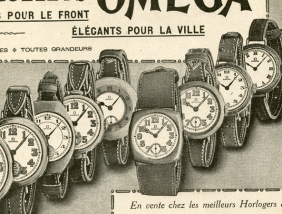Vintage Wristwatches For Sale From The 1910s.
There had been examples of portable timepieces worn on the wrist since the final years of the 19th century, but almost without exception, these had been items of novelty jewellery intended for use by women in the high society salons of the day. Girard-Perregaux famously produced a number of primitive wristwatches for the German navy at the request of Kaiser Wilhelm in 1879, but these had no real impact on prevailing public taste and it wasn’t until World War I that the wristwatch as we know it today really came into being.
The war in France took a different form to that which had previously been seen. Rather than being mobile and moving from engagement to engagement, the two sides were in static positions, deeply dug into trenches with acres of desolate no man’s land between them. Particularly during the harsh winter of 1916, there was the necessity of wearing many layers of heavy uniform in order to try to keep the freezing conditions at bay. The coordination of offensive activity on the front lines meant that accurate timekeeping was crucial, and it was found that a watch worn on the wrist was far more accessible than its traditional equivalent, buried on a chain in a pocket deep on the person. Early wristwatches tended to be pricey, but were adopted widely by officers. Certainly by 1916, all the major Swiss houses including Omega, Longines, Zenith and IWC offered wristwatches intended for male use in their collections. Rolex, very much still an upstart during this period, came from nowhere to occupy pole position in this emerging field largely by embracing the wristwatch concept wholeheartedly at a time when most of its longer established competitors sold wristwatches only with some distain, on the basis that they were little more than a passing fad that would evaporate shortly after the end of hostilities.
The use of wristwatches by veterans returning heroically from the Somme and Passchendale firmly put an end to any effeminate connotations that the genre might have had in the minds of the public in the past. While pocket watches still outsold wristwatches by a factor of many times, the wristwatch was regarded as an acceptable, if new fangled, form of portable timekeeping for gentlemen by 1918.
Perhaps not surprisingly, the appearance of the wristwatches produced at this time has a lot in common with that of the pocket watches from which they were derived. In real terms, an early Rolex, Omega or similar wristwatch from the Great War is basically a smaller version of a pocket watch, onto which wire lugs have been soldered in order that a strap can be attached. Shaped cases hadn’t yet appeared and a circular form was typical, with a hand wound movement and a dial almost universally in hard glazed enamel. Steel hadn’t yet become commonplace as a case material, with the cheaper watches having nickel cases while those sold for larger sums coming in silver and, most prized of all, gold.
From a modern day collector’s point of view, these early officers’ watches are very charming, though certainly in the last decade, good, unmodified examples that aren’t mechanically worn out have become difficult to source. When buying a watch of this kind, look very carefully for signs of changed components in the movement, repairs to the case and hairline cracking to the dial surface. There are a lot of fakes in circulation, with these being typically not modern reproductions but old watches of indeterminate origin from the correct period that have been retrospectively stamped with the appropriate markings to enable them to be passed off as the products of Rolex, Longines, Omega or the other famous houses. Some of these forgeries have been around since the mid-1980s and have acquired a very convincing patina, making them difficult for the newcomer to spot.
One of the most fascinating challenges for the serious enthusiast is to assemble examples of all the significant developments that the wristwatch went through in quick succession in the years between 1914 and the late-1920s. While a watch worn on the wrist was convenient for the wearer when he wanted to quickly tell the time in combat conditions, it was far more exposed to damage from water and shock than its pocket watch ancestor had been. Hunter and semi-hunter wristwatch models appeared, with flip up metal lids designed to offer protection to their fragile glass fronts, and much of the second half of the 1910s was taken up with the race to create the first commercially viable waterproof wristwatch model. This goal wouldn’t be reached until the following decade with the arrival of the Rolex Oyster in 1926, but many of the early moisture proof models that were launched, including the Borgel patent, the semi-hermetic and the hermetic, were stepping stones on the way to this breakthrough and as such, remain historically very important and highly collectible.

Vintage Watch Brands
Vintage Watch Decades
Vintage Ladies Watches
Vintage Watch Bracelets
Swipwreek Straps
Travel Clock/ Pocket Watches
Home
About
Brand Overviews
By Decade
Reference
Reference
Contact Details
07453 734666
or 07428 051005
Telephone from overseas:
+44 7453 734666
or +44 7428 051005

